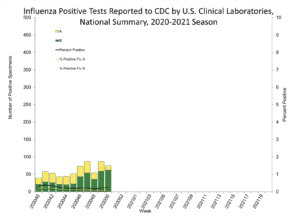Since the COVID-19 virus entered the world stage one year ago, it has been a consistent point of interest in the daily news. This notoriety can make it easy to forget the virus that used to dominate the news: Influenza. The Northern Hemisphere is experiencing unusually low flu activity for this time of year. And it is not just absent from our neck of the woods either. The Southern Hemisphere’s flu numbers remain a fraction of what they were compared to previous flu seasons.

Why Isn’t The Flu As Severe as Previous Seasons?
As mentioned in a previous blog post by VIGILINT’s Senior Intel Analyst Alex Snyder: “Social distancing, increased attention on flu vaccinations, and school policies put in place to prevent the spread of COVID-19 may also prevent the spread of the flu.” This statement proved to be correct, sparing us from the public health impact that dual viruses could have caused.
Every nation has in some way implemented measures to reduce the spread of COVID-19, however, one of the largest factors that contributed to the limited spread of the flu has been the reduction of international travel. Australia reports numbers as low as a .03% detection rate compared to the previous seven years of data despite this season seeing significantly more testing. The same trend can be seen in Chile and South Africa with reductions as high as 98%.
Medical experts cautiously predict that the Northern Hemisphere should also see a mild flu season but that could change. If COVID-19 related restrictions are loosened, we could see an uptick in flu cases. For now, those measures are staying in place.
What Are The After-Effects Of Such A Mild Flu Season?
There are several possible second and third-order effects that could stem from this mild flu season. Some experts foresee difficulty in developing vaccines for future flu seasons, as narrowing down the exact strain of the more infectious virus will be challenging with fewer clues to assist researchers. Some strains of the virus will most likely go extinct, which is not necessarily a bad thing. The surviving strains will most likely be the fittest – which may cause more unique problems of their own. Nothing is for certain though, as the variables influencing the current trends are unpredictable and constantly changing.
It will still be some time before we truly know how COVID-19 permanently altered the seasonal flu. Constant changes in policy could continue to limit its spread or completely reverse it. Limited samples from continuously shrinking seasons may make vaccine development more difficult as time goes on.
